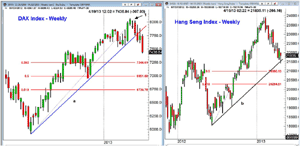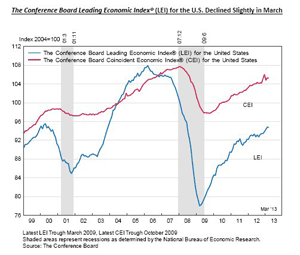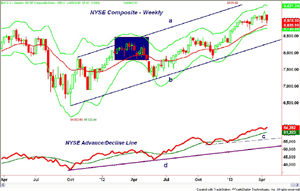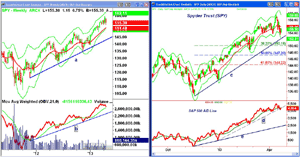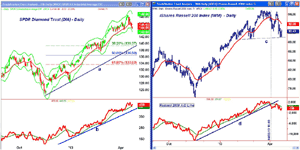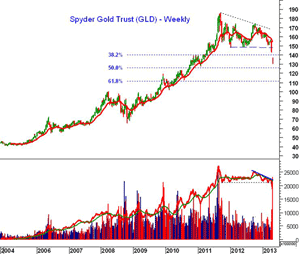There's one key reason why MoneyShow's Tom Aspray believes the eventual correction will be relatively light this year, although he cautions it is a volatile time, and investors should probably move some of their winners to cash if they haven't already.
The global stock markets took a beating last week, with the S&P losing over 2%. The rebound Friday was encouraging, as another down day would have done more technical damage.
A weekly close in the S&P 500 under the lows of the past five weeks at 1,538.57 would have been much more negative. However, small caps were hit even harder, with the iShares Russell 2000 Index (IWM) down over 3%.
In my March column Will Spring Showers Dampen Your Portfolio?, I reviewed the market declines that have happened each spring over the past three years. I pointed out that each near-term top was marked by a sharply lower weekly close, which is what occurred this week in the S&P 500.
The German Dax index had been outperforming the S&P 500 since the June 2012 lows, but topped out six weeks ago. One week after the highs, the Dax formed a doji (point 1), and the following week triggered a low close doji (LCD). The uptrend (line a) was broken three weeks ago.
This week, the Dax violated my key support level at 7,500 and closed below it. The Dax has reached the September 2012 highs, with the 38.2% Fibonacci retracement support to follow at 7,246. This is the next potential downside target.
The Dax is already down 7.6% from its highs, and the 38.2% support is 2.8% below Friday's close. Therefore, if this retracement support is reached, it would be just over a 10% decline from the highs.
Hong Kong's Hang Seng Index is also quite important from a global perspective. It peaked in early February, and is already down 8.8% from its highs. The 38.2% retracement support has already been violated, with the 50% support at 20,986, or 3.8% below Friday's close. The longer-term uptrend (line b) is now being tested.
From the weekly chart of the Hang Seng, one can see that we are already back to the highs from early 2012, which should provide good support.
In March, it was my view that a correction was more likely to resemble the spring doldrums of 2012, when the S&P lost 11%, than the larger declines of 2010 or 2011. Below, I will update the technical evidence that helps support this view.
The economic data last week also worked against the high stock prices. The Empire State Manufacturing Survey was weaker than expected on Monday, as was the Housing Market Index.
Last Tuesday's rally was due in part to the much better than expected industrial production and housing starts data. However, Thursday's Philadelphia Fed Survey was disappointing, as it reflected slowing growth.
NEXT: What to Watch
|pagebreak|One of the economic reports that I watch closely for clues to the condition and future of the markets is the Leading Indicators from the Conference Board.
Their chart shows that both the Leading Economic Index (LEI) as well as the Coincident Economic Index (CEI) are both still clearly rising.
The LEI peaked in 2006, and did not really turn lower until late 2007. It shows no signs of a turn in the economy.
On Monday, we get new existing home sales data and the new home sales report follows on Tuesday. Also on Tuesday the PMI Manufacturing Index Flash is released, and that is likely to give us a reading on the economy's health.
The durable goods report is out on Wednesday, followed Thursday by jobless claims, which have risen four out of the five past weeks. Then on Friday, we get the advance reading on GDP for the first quarter and the final reading for April on consumer sentiment from the University of Michigan.
What to Watch
It seems like a very long time since the 100-plus point decline on April 3. I saw this as a cautionary note, and called it a "yellow flag" for both investors and traders.
As we all know, the Dow Industrials and the S&P 500 both subsequently made new highs. It now looks in hindsight like the early release of the FOMC minutes on April 10 cleared out many of those who remained on the short side.
Many stocks have been hit this week. Those that disappointed on earnings saw the largest declines. Several of the Dow stocks on the most oversold list have been hit with heavy selling; Hewlett-Packard (HPQ) is down almost 18% since the start of the month.
This week, bullish sentiment according to the AAII rebounded to 26.8%, partially because the prior week's reading had a low sample size. If the stock market declines for another three to five weeks, this number should drop back to the 20% level or lower.
The number of bullish financial newsletter writers dropped slightly to 47.4%, but you will recall they never turned very negative, even at the lows in 2012.
The reason I am looking for a smaller correction is that the weekly studies on the S&P 500 and NYSE Composite have not formed any significant negative divergences, like they did prior to the 21% slide in 2011. There have been some divergences in the daily studies, as the number of NYSE stocks making new highs has been deteriorating since early in the year.
The H-L indicator I discussed in Tracking the Market's Trend did turn negative this week. This is consistent with a correction, but the fact that the daily and weekly NYSE Advance/Decline line have continued to make new highs with price is positive for the intermediate-term trend.
The weekly chart of the NYSE Composite shows that it reached its lowest level in the past six weeks, but did close above its lows. The close was also above the quarterly pivot at 8,938. The 20-week EMA is at 8,834, and the NYSE is not too far above its weekly Starc- band at 8,729.
The 38.2% Fibonacci support from the June lows sits at 8,478, which coincides with the weekly uptrend (line b). This is just over 5% below Friday's close.
I have highlighted the top that formed in 2012, when it took almost three months before the selling became quite heavy. This suggests that we could bounce around between last week's lows and the recent highs for a few more weeks before we drop to stronger support.
The weekly A/D line is holding up pretty well, and is still above its rising WMA. There is further support at line c. The major support for the A/D line goes back to the 2011 lows (line d).
There is resistance now for the NYSE between 9,131 and the high at 9,256.
NEXT: Stocks
|pagebreak|S&P 500
The weekly chart of the Spyder Trust (SPY) shows the lower close last week after the previous week's new highs at $159.71, which was just below the quarterly R1 at $160.31.
The 20-week EMA is now at $151.48, which is well below last week's lows at $153.55. The longer-term uptrend (line a) is now in the $144.50 area.
The weekly on-balance volume (OBV) has turned lower, as the volume last week was quite high. The OBV formed a slight divergence at the recent highs, and the length of the divergence can often be used to determine the extent of the correction. The OBV is above its WMA, and well above the stronger support (line b).
As I noted in Friday's column, the key daily support at $153.77 was broken last week before the SPY rebounded. Thursday's lows were close to the daily Starc- band, with the 20-day EMA a bit above Friday's close at $155.94.
The daily uptrend (line c) is in the $152 area, with the 38.2% Fibonacci support at $150.18. More important support follows at $148.73 (the late February lows), and the 50% retracement support waits at $147.20.
The S&P 500 A/D line did confirm the recent highs, but slightly violated its short term uptrend (line d) last week. The longer-term support is at line e. The A/D line closed slightly above its WMA.
Dow Industrials
The SPDR Diamond Trust (DIA) held up pretty well last week, as it has been performing better than the S&P 500 based on relative performance analysis.
It did not violate the support at $143.48, while the corresponding support in the S&P 500 was broken. A break of this support would suggest a drop to the $140 area, or the 38.2% Fibonacci support at $139.37.
The daily Dow Industrials A/D line did not break its WMA last week, and turned up with Friday's higher close. As I pointed out last week, it made significant new highs with prices, which is a sign of strength.
A close back above the $146.60 level would be a plus. The quarterly R1 resistance stands at $149.81.
Russell 2000
The iShares Russell 2000 Index (IWM) has been the weakest of the ETFs over the past month, but it appears to be holding support in the $89.70 to $89 area.
The quarterly pivot is at $91.50, which is the next barrier on the upside. The declining 20-day EMA sits at $91.99.
The Russell A/D line did turn up last week, but broke its uptrend (line d) on April 2, which was a sign of weakness. It shows a pattern of lower highs and lower lows. It would need to move above its prior high to turn positive.
NEXT: Sector Focus, Commodities, and Tom's Outlook
|pagebreak|Nasdaq-100
The PowerShares QQQ Trust (QQQ) dropped below the prior low at $67.19 last week, but was quite strong Friday, so it closed well above the lows. The daily chart (not shown) meets its next resistance at $68.89 to $69.47.
The Nasdaq-100 A/D line did confirm the recent highs, and did not break support last week, despite the negative news on the tech sector. QQQ has support at $66.88, which was last week's low, and the quarterly S1 waits at $66.61.
Sector Focus
The iShares Dow Jones Transportation (IYT) stabilized last week, with Friday's close forming a daily HCD, which is a short- term buy signal.
At the early April lows, it was 7% below its highs, which is not too bad. The close last week was back above the quarterly pivot support at $105.99, but the daily OBV (not shown) is still negative.
The standout sector last week was Select Sector SPDR Consumer Staples (XLP), which closed at new highs for the year, as did the Select Sector SPDR Utilities (XLU). The Select Sector SPDR Health Care (XLV) also held up well. All were discussed in 2013's Top Four Sectors.
Two of the worst performers were the Select Sector SPDR Energy (XLE), down about 4.8%, and the Select Sector SPDR Technology (XLK), which lost 3.4%. The daily chart of the XLE formed a doji on April 11 (point 1) and closed below the doji low the next day, triggering an LCD, which was the subject of this week's Trading Lesson.
XLE then broke support (line a) and has now hit the quarterly S1 support, with further support in the $72 area. The OBV is below its WMA, but has not yet broken its support (line b).
The Select Sector SPDR Technology (XLK) broke support (line c) that went back to mid-January late last week. The break was confirmed by the violation of long-term OBV support (line d). This suggests that tech is not going to be a market leader for some time.
Crude Oil
It was another tough week for crude oil, as the June contract dropped over $2.40 per barrel for the second week in a row. The early March low of $90.23 was violated, reaching as low as $85.90 before rebounding to close at $88.18.
Precious Metals
The selling was even heavier in the gold market, and it makes one wonder whether deflation will be the real problem facing our economy. The weekly chart shows that the Spyder Gold Trust (GLD) gapped below the 38.2% Fibonacci support that goes back to the 2008 lows. The volume was very heavy, as the weekly OBV broke support a few weeks ago.
The 50% support level sits at $125.82, which could be reached before the selling is over.
The Week Ahead
I expected last week to be a difficult one for the stock market, and the gyrations are likely to continue for the next several weeks. I was surprised a bit by Friday's strength. Another sharply lower close could have changed the technical outlook.
The S&P 500 and Dow Industrials, which are the strongest averages, need several consecutive higher closes to turn the focus back on the upside. However, the damage in both the energy and technology sectors has me concerned. By the middle of this week, the short-term technical picture should be clearer.
I hope you reduced your exposure on the long side over the past month. In this environment, I think a higher than average cash level is a good idea. The high-yielding large-cap stocks will be my favorites for bargain hunting if they reach good support.
- Don't forget to read Tom's latest Trading Lesson, A Candle Trigger for Market Tops

